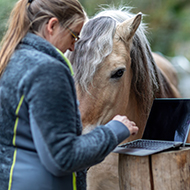Movement data could help control cattle diseases, study finds
Agriculture forms a major part of Uganda's econony.
An international team of researchers has analysed the movement of cattle in Uganda, identifying critical hubs that could be targeted for disease surveillance.
An estimated 15.5 million cattle are kept in the East African country. Transboundary animal diseases (TADs) such as foot-and-mouth disease, bluetongue, and contagious bovine pleuropneumonia, can have a major impact on livelihoods as well as animal health.
The research team, which included researchers from the Roslin Institute and the University of Makerere in Uganda, analysed cattle movement data sourced from Uganda’s Ministry of Agriculture, Animal Industry and Fisheries.
The analysis identified major trading hubs and seasonal patterns in cattle movements, information that could help authorities to manage TADs and optimise disease control measures. Based on the findings, the researchers have piloted a disease surveillance system using environmental and animal samples collected at livestock markets.
As well as publishing the results of their analysis, the researchers have also published detailed steps on how to gather and map the data, to help policymakers and other researchers.
Lina Gonzalez Gordon, first author of the study, said: “We have been contacted by groups interested in using this approach, as the analysis can be easily conducted by veterinary epidemiologists who may not have access to advanced technology and resources, but want to enhance the value of their existing data for strategic decision-making, as well as to identify gaps in their monitoring systems for livestock movements.
“By leveraging this knowledge, authorities can better safeguard livestock populations and protect the nation's agricultural economy through targeted, risk-based approaches.”
The study has been published in the journal Nature Scientific Reports.
Image © Shutterstock



 With Strangles Awareness Week just around the corner (5-11 May), vets are being encouraged to share a survey about the disease with their horse-owning clients.
With Strangles Awareness Week just around the corner (5-11 May), vets are being encouraged to share a survey about the disease with their horse-owning clients.